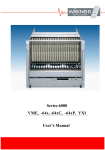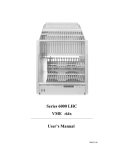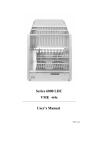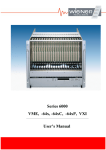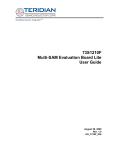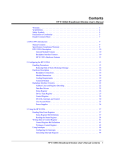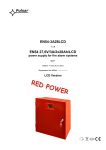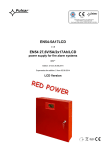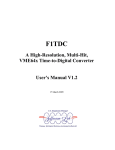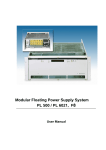Download Series 6000 CERN VME, -64x, -64xC,
Transcript
Series 6000 CERN VME, -64x, -64xC, -64xP User’s Manual *00571.A0 General Remarks The only purpose of this manual is a description of the product. It must not be interpreted as a declaration of conformity for this product including the product and software. W-Ie-Ne-R revises this product and manual without notice. Differences of the description in manual and product are possible. W-Ie-Ne-R excludes completely any liability for loss of profits, loss of business, loss of use or data, interrupt of business, or for indirect, special incidental, or consequential damages of any kind, even if W-Ie-Ne-R has been advises of the possibility of such damages arising from any defect or error in this manual or product. Any use of the product which may influence health of human beings requires the express written permission of W-Ie-Ne-R. Products mentioned in this manual are mentioned for identification purposes only. Product names appearing in this manual may or may not be registered trademarks or copyrights of their respective companies. No part of this product, including the product and the software may be reproduced, transmitted, transcribed, stored in a retrieval system, or translated into any language in any form by any means with the express written permission of W-Ie-Ne-R. Mains Voltage and Connection The Power supplies are equipped with a “World”- mains input, which works properly form 94VAC up to 264VAC and within a frequency range of 47 to 63Hz. Before connecting to the mains please double-check correspondence. The mains input connection at the power supply side is done with a 3-pin Hirschmann connector (input current max. 16 A) or power terminals. Hirschmann Pin No. Signal Description Color of the Wire Pin 1 L Phase black or brown Pin 2 N Return, Neutral blue Pin 3 Earth not connected PE Protective Earth green/yellow Safety After connecting the Power box to the mains, the mains input module is powered permanently. Filter and storage capacitors of the power factor correction module are charged with about 400VDC. The DC-On-Signal as well as a power switch at control board (if any installed) operates as a DC on/off switch only and not as a mains breaker. Therefore it becomes dangerous if the box cover is open. In this case a lot of components on high voltage potential get touchable! Before starting any kind of work inside the power box remove the unit from mains and wait a couple of minutes with your activities! Discharge the primary DC Filter-capacitors by use of a well isolated 22 ohm 10W resistor. We recommend in case of any male function to send the power box to Wiener or to one of our representative for service Grounding Stud Each VME- bin is outfitted with a grounding stud which has to be wired to mains earth or zero potential line according to Cern’s rule / law. The stud is situated at the right side panel behind the fan space (rear view). June 02 i *00571.A0 Declaration of Conformity Art. 10.2 of 89/336 and 89/392 / ECC W-Ie-Ne-R Plein & Baus GmbH declare under our own responsibility that the product VME / 6021Crate Items: 0B0x.xxxx, 0F0x.xxxx, 0P0x.xxxx to which this declaration relates, is in conformity with the following standards or normative documents : 1. EN 50 081 - 1 2. EN 61 000 3 - 2 3. EN 50 082 - 1 4. EN 60 950 Conditions: This crate is not a final product. The use after installation and powered modules inside needs possibly additional screenings to be in conformity of the definition. Admitted for powering by all mains. Name and signature of authorized person Place and Date Name und Unterschrift des Befugten Ort und Datum Juergen Baus Techn. Director June 02 Febr. 2000 ii *00571.A0 Table of contents: 1 General Information ......................................................................................................... 5 1.1 6021 Crates.................................................................................................................. 5 1.2 6020 Fan Trays ........................................................................................................... 5 1.2.1 LX Fan Trays ....................................................................................................... 5 1.2.2 EC Fan Trays........................................................................................................ 6 1.3 6021 Power Supplies................................................................................................... 6 2 Operation, Function and Connections .............................................................................. 6 2.1 Fan Tray Operation and Control............................................................................. 6 2.1.1 Function of Fan Tray Switches ............................................................................ 7 2.1.2 Additional temperature sensors ............................................................................ 8 2.1.3 Information by Fan Tray LED’s........................................................................... 8 2.1.4 Hot Swapping of LX Fan Tray 1........................................................................... 8 2.1.5 Programming of Fan tray ..................................................................................... 9 2.2 6021- Bin Technical details...................................................................................... 12 2.2.1 VME-Bus Terminology, Signal Identification ................................................... 12 2.2.2 VME ( ) Bus Current Ratings............................................................................. 13 2.2.3 Pin Assignments of J1 and J2 VME Bus............................................................ 15 2.2.4 Pin Assignment Jaux of VME 430-Bus (CERN) ............................................... 16 2.2.5 Pin Assignments of VME 64x-Bus .................................................................... 18 2.2.6 Pin Assignment J0 of VME 64xC –Bus (CERN)............................................... 21 2.2.7 Special Pin Assignment J0 of VME 64xP - Bus (VIPA) ................................... 22 2.3 Power Supply UEP6021 ........................................................................................... 23 2.3.1 Power Connector Board (Fork Contacts) ........................................................... 23 2.3.2 Sense and Signal Connector-SUB D 37 ............................................................ 24 2.3.3 Fan tray and Control Connector SUB D9........................................................... 24 2.3.4 Control and Adjustment of 6021 Power Supply................................................. 25 2.3.5 Connection of a Personal Computer to the Power Supply UEP6021................. 27 2.3.6 Output Voltage Adjustments .............................................................................. 28 2.3.7 Monitoring Connector ..................................................................................... 28 2.3.8 CANbus Option, Transmission Speed Index...................................................... 29 APPENDIX A : Technical Details of 6021 Power Supplies................................................. 30 APPENDIX B : Typical Module Efficiency ......................................................................... 31 APPENDIX C : DUT Conditions, Power Supply ................................................................ 33 APPENDIX D : Technical Details of Fan Trays................................................................... 34 APPENDIX E : VME 430 Backplane, Situation of Jaux Connector .................................... 35 APPENDIX F : VME 64xC Backplane, Situation of J0 Connector...................................... 36 June 02 iii *00571.A0 June 02 iv *00571.A0 User’s Manual VME 6021 CERN W-Ie–Ne-R Plein & Baus GmbH 1 General Information 1.1 6021 Crates The VME -Crate 6021 consist of a power supply (UEP 6021), bin (UEV 6021) and a fan tray (UEL 6020). All these components are plugged and easily to exchange.. Divider sets 6U/9U can be mounted into bins for 9U format modules. For powering of 6021 bins same UEP 6021 power supplies have to be used. Available W-Ie-Ne-R VME backplanes: VME64 with J1/J2, VME430 with J1/Jaux/J2, VME64x, VME64xP, VME64xC with Jo special (Cern). 1.2 6020 Fan Trays The-fan trays are plugged into the bin from the front side. For efficient cooling, controlling and monitoring of the crate various fan trays are constructed according to the slot deepness, whereas both, front and bottom air supply, is possible. Fan rotation speed is shown by use of LX fan trays and can be regulated; every fan is single controlled. Furthermore temperature of the air entry and optionally the exhaust above selected slots. The UEL 6020 fan tray and control unit occupies two units of a 6021 crate below the VME / -bus slots. To achieve an excellent airflow homogenization through the inserted VME modules, all fan trays for 400mm modules (and larger ones) are outfitted with a topped plenum chamber which acts as a pressure volume below the VME modules. Among the different types high performance super blower with four or six blowers can be used, too. While 3 fold fan-tray can operate either with air is taken from the front and then pushed upwards to the modules or from bottom side, which gives full cooling efficiency. Deeper fan trays needs bottom sucking, otherwise the airflow would be limited by the front intake gaps. For instance: The maximal air flow reached by a 3-fold W-Ie-Ne-R fan-tray (2U) with frontal inlet is not greater than 400 m3/h. With bottom intake and free entry the airflow can rise up to 540 m3/h. The EC fan tray is the economic version and equipped with same blower than the LX version. Therefore both types give the same cooling performance and are pin compatible 1.2.1 LX Fan Trays All DC voltages (up to 8) at backplane level and the corresponding currents among other are shown by the LX monitoring. The threshold-limits (minimum / maximum voltages and currents) can be set manually or piloted by remote control and remain stored even after lack of voltage. In case of global trip off, the fault will be displayed by the diagnostic system. VME-signals ACFAIL and SYSRESET are generated according to VME-Specs. SYSRESET can also be released manually. Remote-control by network (CANbus, IEC-Bus or H.S.CAENET) is optionally possible, whereas IEC and H.S. CAENET need the intelligent version of fan trays (LX), the CANbus may operated with all kind of fan trays. Furthermore, remote control and monitoring of several crates is possible through a PC's compatible program. Change of trip off limits (specially for currents) through menu is possible (Option). Piloting circuits are isolated from VME-potential. June 02 5 *00571.A0 User’s Manual VME 6021 CERN W-Ie–Ne-R Plein & Baus GmbH 1.2.2 EC Fan Trays The simplified fan tray, UEL 6020 EC, has no further facilities than DC on / off switch and Power LED which works also as Status indicator. Optionally outfitted with CANbus connection. Full performance of CANbus is given only when the DC on / off switch is in ON position. 1.3 6021 Power Supplies The VME power supply of the 6000 series is a micro-processor controlled switching power supply designed in the high density W-Ie-Ne-R - cavity technology, which provides a very low noise output voltage. The mains input includes a power factor correction module which works according to EN 60 555-2/IEEE 555-2 (PFC). An external fuse or circuit breaker has to be installed (16A for 3U boxes with 2.5kW and 32A for 6U boxes with 5kW). The turn-on inrush current is limited by a soft start-circuit to a maximum value of about 12A (24A) when the cold unit has been connected to the mains. The AC- input module is permanently powered after connecting the unit to the AC- mains. POWER ON/OFF activates only the DC on/off function of the power inverter modules. The EN 50 081-1 for generic emissions as well as the EN 50 082-1 or 2 for immunity standards, in particular EN 55 011 RFI rejection (incl. VDE 0871 class B) and EN 55 022 electromagnetic compatibility is accomplished. The insulation performs the EN 60 950, ISO 380, VDE 0805 (SELV)! Furthermore are considered UL 1950, UL 1012, UL 478, C 22.2.950, C 22.2.220/234. Therefore the UEP 6021 power supplies can fulfil the CE rules comprehensively and will CE marked for use at all power nets. Turning on the power supply all voltages reach the nominal values nearly simultaneously within 50 ± 2.5 ms (start-end-time) whereby the voltage versus time curve shows a monotonic behavior. The switch-off-time which corresponds to a value of 10% of the nominal DC voltages is reached after 5±2.5 ms. The power packs are readily replaceable. The maximum output power is ca. 1000... 2800W for a 3U power box, while a 6U box may have the double utilization. The available DC output power is in correspondence with the 92... 265VAC input voltage. Also the installed modules urge the efficiency (3,3V module efficiency is some lower then those of a 48V module). In practice for 230VAC mains more than 2600W for a 64x power supply with all fife standardized outputs is provided. Booster mode with 400VDC as input voltage is possible (special terminals are requested). This makes 4500 W DC output possible with a 3U power box 2 Operation, Function and Connections 2.1 Fan Tray Operation and Control. All monitoring and control operations are performed by a micro-processor based alarm and control circuit placed inside the UEP 6021 power supply monitored by UEL 6020LX (EC via CANbus only) fan trays. To protect both the power supply and the VME modules, a DC cut-off is started in the case of: • overheat: June 02 in the power modules (each module is equipped with temperature sensors); 6 *00571.A0 User’s Manual W-Ie–Ne-R VME 6021 CERN Plein & Baus GmbH • overload: if maximal current is exceeded (trip-off due to programmed lower values is not indicated as overload) • overvoltage: if voltage >125% (default, crow bar function) and if voltage >105% (default, can be changed via LX fan tray or network) • undervoltage: if voltage <97.5% % (default, can be changed via LX fan tray or network) • fan failure: if one or more fans fail The reasons of a trip off will be displayed on the alphanumerical LX display. Voltages, currents, cooling air temperatures (selectable °F - °C), fan speed, power dissipation of inserted modules, operation time of power supply and fan tray and optional net parameters, can be shown on the alphanumeric display of the fan-tray. The ADC resolution is 10 bit. The accuracy of the voltage measurement is better than 0.5%. The total accuracy of the current measurement depends on the corresponding voltage, i.e. for ±5V it is better than 2A in the range between 5A - 50A and for -2V it is better than 1A in the range between 1A 20A. Above these current ranges the accuracy is <5% of the final value. In the case of ±12V and ±15V the accuracy is better than 0.2 in the whole current range. 2.1.1 Function of Fan Tray Switches POWER ON /Off main switch for ventilation and power supply MODE SELECT selection switch to choose items and values for fan-tray and power supply monitoring and control SYS RES protected located switch for VME SYSRESET circuit activation FAN SPEED push button for step wise in- or decrease of fan speed. one of two functions, selected by software (see 2.1.5): FAN AUTO OFF 1: Switch off after fan-failure (yes/no) 2: Activate the “hot swap” function of the fan 1 ADDRESS LOCAL Optional if remote network is installed Optional if remote network is installed (IEC Bus only) The adjusting range of fan speed is from 1200 RPM up to >3000 RPM. Pre selected reference speed and displayed value are average RPM. The display shows the fan speed in flashing mode if the selected speed is not equal with the true speed. This happens when either the fans are still accelerated to the higher turns or the selected value is not reachable (if >3000 RPM and higher density modules inserted in the bin, etc.). After a certain time the FAN FAIL circuit will detect this status as fan fail! While the display shows average speed June 02 7 *00571.A0 User’s Manual W-Ie–Ne-R VME 6021 CERN Plein & Baus GmbH of all fans only, the CANbus option (or other supported remote interfaces) will transmit the turns of each blower situated inside the fan tray. 2.1.2 Additional temperature sensors Optionally installed temperature sensor(s), measuring the exhaust air, allows to switch the fan to stop. That will be achieved by keeping pushed the FAN SPEED button to lower speed about 10 seconds. Also the sensor(s) will • accelerate the fan speed to the maximum if the first (FanUp) programmed temperature threshold exceeds (default: 45°C) . During the out coming cooling air is above these thresholds, adjustment to lower fan turns is disabled, until the exhaust temperature is below the limits again. • switch off the power supply if the second (PsOff) programmed temperature threshold exceeds (default: disabled) . The sensors are placed normally above selected slots at the bin. In combination with EC fan trays these sensors can substitute the function of the LX fan fail circuit, partially. 2.1.3 Information by Fan Tray LED’s AC POWER STATUS FAN FAIL OVERHEAT SYS FAIL green large LED if POWER is on green LED if all voltages are within the limit yellow LED if a fan failure is recognized yellow LED if an overheat in the power supply occurs red LED if VME-bus system generates the SYSFAIL signal (system failure) FAN SPEED Red LED if fan speed below 100% AUTO OFF red LED indicates DC cut off disabled, remote warning only, hot swapping of fan tray possible now LOCAL Optional if remote network is installed 2.1.4 Hot Swapping of LX Fan Tray 1 If the “hot swap” function of the fan is activated, the crate may be fully powered during withdrawal of the fan tray. The max. DC- on time has to be programmed (see 2.1.5). If programmed PsOff- limits of optional installed temperature sensors exceed during fan tray exchange the power supply will trip off to prevent any damage to inserted modules. June 02 8 *00571.A0 User’s Manual VME 6021 CERN W-Ie–Ne-R Plein & Baus GmbH 2.1.5 Programming of Fan tray Fan tray parameters (and in the same way many power supply parameters!!) may be changed via the alphanumeric control. The general procedure is: - Switch the POWER and the MODE switch up simultaneous for 5 seconds. The display shows „Config: Wait....“ and „Config: Ready !“. Then release both switches. - If a sub-menu exists, you may now select the sub-menu item (MODE switch up/down). If no sub-menu exists, you may change the parameter value (MODE switch up/down) - To change a parameter of a sub-menu, select it (POWER switch up). The selected parameter is flashing now. - You may alter the parameter now (MODE switch up/down) - After finishing the parameter programming, leave the submenu or configuration menu (POWER switch down). Programmable parameters of a fan tray: Mode associated parameter submenu Description Fans Watching x Fans Display of the number of monitored fans Fan Temp Temp Display: °C Select the temperature unit: Celsius or Fahrenheit Temp Display: °F Function of the FAN AUTO OFF DIS: The switch will disable the AUTO OFF switch 1 trip off of the power supply if the fans are not working correct. (DANGER: The VME modules may burn! Should be used only for service purpose.) HOT SWAP time: The switch will activate the “hot swap” feature. The maximum time the user has got to change the fan tray is set here. Bin Temp x PsOff ( < 8 sensors), also with EC FanUp fans If the temperature of sensor x is above this limit, the power supply will switch off. If the temperature of sensor x is above this limit, the fan speed will increase to full speed. 1 Implemented in systems produced after October 2000 only June 02 9 *00571.A0 User’s Manual VME 6021 CERN W-Ie–Ne-R Plein & Baus GmbH LX 6020 fan-tray front panel with optional CAENET interface June 02 10 *00571.A0 User’s Manual VME 6021 CERN W-Ie–Ne-R Plein & Baus GmbH Standard Measurement Ranges Available Modes and Display Examples (LX Fan trays only) Mode Monitored Values Description +5V 5.00 V 115A.... 230A (460) +5V channel +12V 12.0 V 11.5 / 46.0A (92) +12V channel +15V 2 15.0 V 11.5 / 35.0A (70) +15V channel +3,3V 3.30 V 115.... 230A (460) 3,3V channel 48,0 V 13,5... 67A 5.20 V 100A.... 400A -5.2V channel 12.0 V 6.0 / 10.0 / 40.0A (80) -12V channel 15.0 V 6.0 / 10.0 / 30.0A (80) -15V channel 2.00 V 100.0A.... 200A -2V channel POWER 135 W output power FANS 3000 RPM fan rotation speed FAN TEMP 25 ° C or °F fan air inlet temp. FAN TIME 82000,6 h Operating time Fan tray P.S. TIME 150000,0 h Operating time Power Supply 35°C ° C or °F bin slot 1 (?) temp. ° C or °F bin slot 2 (?) temp. ° C or °F bin slot 8 (?) temp. +48V 2 -5V -12V -15V 2 -2V Options BIN TEMP 1 BIN TEMP 2 ....... up to BIN TEMP 8 Networks * CAEN* ADDR 99 CAENET address BAUD* RATE 1 MBAUD CANbus bit rate CANbus* ADDR 127 CANbus address IEC* ADDR 25 IECbus address 2 Either 15V or 48V- output will be in use, depending on the application (VME 430, VME64x) June 02 11 *00571.A0 User’s Manual VME 6021 CERN W-Ie–Ne-R Plein & Baus GmbH 2.2 6021- Bin Technical details 2.2.1 VME-Bus Terminology, Signal Identification BR0*-BR3* Bus request (0-3). Open-collector driven signals generated by requesters. A low level on one of these lines indicates that some master need to use the DTB D00-D31 Data bus. Three-state driven bi-directional lines used to transfer data between masters an slaves, and status/ID information from interrupters to interrupt handlers. DS0*, DS1* Data strobe zero, one. Three-state driven signals used in conjunction with LWORD* and A01 to indicate how many byte locations are being accessed (1, 2, 3, or 4). In addition, during a write cycle, the falling edge of the first data strobe indicates that valid data is available on the data bus. On a read cycle, the rising edge of the first data strobe indicates that data has been accepted from the data bus. DTACK* Data transfer acknowledge. An open-collector driven signal generated by a SLAVE. The falling edge of this signal indicates that valid data is available on the data bus during a read cycle, or that data has been accepted from the data bus during a write cycle. The rising edge indicates when the slave has released the data bus at the end of a read cycle. GND the dc voltage reference for the system IACK* interrupt acknowledge. An open-collector or three-state driven signal used by an interrupt handler to acknowledge an interrupt request. It is routed, by way of a backplane signal trace, to the IACKIN* pin of slot 1, where it is monitored by the IACK daisy-chain driver. IACKIN* interrupt acknowledge in. A totem-pole driven signal. The IACKIN* and IACKOUT* signal indicates to the board receiving it that it is allowed to respond to the interrupt acknowledge cycle that is in progress. IACKOUT* Interrupt acknowledge out. A totem-pole driven signal. The IACKIN* and IACKOUT* signal is sent by a board to indicate to the next board in the daisy-chain that it is allowed to respond the interrupt acknowledge cycle that is in progress. IRQ1*-IRQ7* Interrupt request (1-7). Open-collector driven signals, that are driven low by interrupters to request an interrupt. When several lines are monitored by a single handler the highest numbered line is given the highest priority. LWORD* Longword. A three-state driven signal used in conjunction with DS0*, DS1*, and A01 to select which byte location(s) within the 4-byte group are accessed during the data transfer. RESERVED Reserved. A signal line reserved for future enhancements. SERCLK Serial clock. A totem-pole driven signal that is used to synchronize the data transmission on the VMSbus. June 02 12 *00571.A0 User’s Manual W-Ie–Ne-R VME 6021 CERN Plein & Baus GmbH SERDAT* Serial data. An open collector driven signal that is used for VMSbus data transmission. SYSCLK System clock. A totem-pole driven signal that provides a constant 16 MHz clock signal that is independent of any other bus timing. SYSFAIL* System reset. An open-collector driven signal that indicates when a failure has occurred in the system. This signal can be generated by any board in the system. SYSRESET* System reset. An open-collector driven signal, which when low, causes the system to be reset. WRITE* Write. A three-state driven signal generated by the master to indicate whether the data transfer cycle is a read or write. A high level indicates a read operation; a low level indicates a write operation. + 5 V STDBY + 5V dc standby. This line supplies 5 V dc to devices requiring battery backup. + 5V + 5 V dc power. Used by system logic circuits. + 12 V + 12 V dc power. Used by system logic circuits. - 12 V - 12 V dc power. Used by system logic circuits. 2.2.2 VME ( ) Bus Current Ratings Power distribution VME VME VME VME 430 VME 64x each slot (20°C / 70°C) J1 J2 J1-J2 J1-Jaux-J2 J1 3,3V 17/12A 5V 9,5/7,5A +/-12V 3,2/2,5A 9,5/7,5A 19/15A 19/15A 8,5/6A 3,2/2,5A 3,2/2,5A 1,7/1,2A +/-15V 3,2/2,5A -5,2V 19/15A -2V 9,5/7,5A Vw, Vx, Vy, Vz V1, V2 1,7/1,2A Layers 8 Type of ADC mech Termination on board passive J2 with 160pin Power Connections June 02 Studs 4 8 8 10 mech mech active passive passive passive active optional optional optional Studs Studs Studs 13 Bugs *00571.A0 User’s Manual W-Ie–Ne-R VME 6021 CERN Plein & Baus GmbH Bus current ratings Power distribution VME 64x VME64xP VME 64x C each slot (20°C / 70°C) J1-Jo-J2 J1-Jo-J2 Slot 2- 213 J1-J2-J3 3,3V 17/12A 17/12A 17/12A 5V 15,3/10,8A 27/19A 15,3/10,8A +/-12V 1,7/1,2A 1,7/1,2A 1,7/1,2A Aux 1 28/28A4 Aux 2 28/28A4 Aux 3 28/28A4 +/-24V Vw, Vx, Vy, Vz 4/3A 4/3A V1, V2 1,7/1,2A 1,7/1,2A Layers 10 18 10 Type of ADC active active active Termination on board active active active Power Connections Bugs Bugs Bugs 3 On slot 1 of the 64xP backplane the Jo is not feeding additional 5V pins. Therefore the current capability for +5V is only 15,3/10,8A. 4 64xC Backplane: 32,5A if all 5 pins in parallel carry same 6,5A current June 02 14 *00571.A0 User’s Manual W-Ie–Ne-R VME 6021 CERN Plein & Baus GmbH 2.2.3 Pin Assignments of J1 and J2 VME Bus J1 Pin J2 Row A Row B Row C Row A Row B Row C 01 D00 BBSY* D08 User defined +5 V User defined 02 D01 BCLR D09 User defined GND User defined 03 D02 ACFAIL* D10 User defined Reserved User defined 04 D03 BG0IN* D11 User defined A24 User defined 05 D04 BG0OUT* D12 User defined A25 User defined 06 D05 BG1IN* D13 User defined A26 User defined 07 D06 BG1OUT* D14 User defined A27 User defined 08 D07 BG2IN* D15 User defined A28 User defined 09 GND BG2OUT* GND User defined A29 User defined 10 SYSCLK BG1IN* SYSFAIL* User defined A30 User defined 11 GND BG3OUT* BERR* User defined A31 User defined 12 DS1* BR0* SYSRESET* User defined GND User defined 13 DS0* BR1* LWORD* User defined +5 V User defined 14 WRITE* BR2* AM5 User defined D16 User defined 15 GND BR3* A23 User defined D17 User defined 16 DTACK* AM0 A22 User defined D18 User defined 17 GND AM1 A21 User defined D19 User defined 18 AS* AM2 A20 User defined D20 User defined 19 GND AM3 A19 User defined D21 User defined 20 IACK* GND A18 User defined D22 User defined 21 IACKIN* SERCLK A17 User defined D23 User defined 22 IAOUT* SERDAT A16 User defined GND User defined 23 AM4 GND A15 User defined D24 User defined 24 A07 IRQ7* A14 User defined D25 User defined 25 A06 IRQ6* A13 User defined D26 User defined 26 A05 IRQ5* A12 User defined D27 User defined 27 A04 IRQ4* A11 User defined D28 User defined 28 A03 IRQ3* A10 User defined D29 User defined 29 A02 IRQ2* A09 User defined D30 User defined 30 A01 IRQ1* A08 User defined D31 User defined 31 -12 V +5V STDBY + 12 V User defined GND User defined 32 +5 V +5V +5V User defined + 5 V User defined No. June 02 15 *00571.A0 User’s Manual W-Ie–Ne-R VME 6021 CERN Plein & Baus GmbH 2.2.4 Pin Assignment Jaux of VME 430-Bus (CERN) Pin Number Row A Row B Row C 01 SN1 GND SN2 02 SN3 GND SN4 03 SN5 GND GND 04 CK* GND CK 05 SG* GND SG 06 CL* GND CL 07 -2 V -2 V -2 V 08 - 15 V CE + 15 V 09 - 5,2 V -5,2 V - 5,2V 10 - 5,2 V - 5,2 V - 5,2V 2.2.4.1 Terminology and Signal Identification of Jaux SN1... SN5, Binary coded slot No. lines, Geographical address Slot Number SN1 SN2 SN3 SN4 SN5 01 NC GND GND GND GND 02 GND NC GND GND GND 03 NC NC GND GND GND 04 GND GND NC GND GND 05 NC* GND NC GND GND 06 GND NC NC GND GND 19 NC NC GND GND NC 20 GND GND NC GND NC 21 NC GND NC GND NC NC = No Connection (represents H- level, generated by 5k6 resistor on VME modul for TTL, e.g.) CK, SG and CL signals, Clean Earth CK, Clock signal, bussed differential line terminated on both sides of the backplane (2 resistors to ground and 1 resistor in between the two lines according to the impedance . CK CK* June 02 positive logic negative logic 16 *00571.A0 User’s Manual VME 6021 CERN W-Ie–Ne-R Plein & Baus GmbH SG, Start / Stop Gate, bussed differential line terminated like CK lines. SG SG* positive logic negative logic CL, Clear, bussed differential line terminated like CK lines. CL CL* positive logic negative logic CE, Clean Earth , unbussed line without termination. June 02 17 *00571.A0 User’s Manual W-Ie–Ne-R VME 6021 CERN Plein & Baus GmbH 2.2.5 Pin Assignments of VME 64x-Bus J1 (extended) Pin No. Row Z Row A Row B Row C Row D 01 MPR D00 BBSY* D08 VPC (1) 02 GND D01 BCLR* D09 GND (1) 03 MCLK D02 ACFAIL* D10 +V1 04 GND D03 BG0IN* D11 +V2 05 MSD D04 BG0OUT* D12 RsvU 06 GND D05 BG1IN* D13 -V1 07 MMD D06 BG1OUT D14 -V2 08 GND D07 BG2IN* D15 RsvU 09 MCTC GND BG2OUT* GND GAP* 10 GND SYSCLK BG1IN* SYSFAIL* GAO* 11 RESP* GND BG3OUT* BERR* GA1* 12 GND DS1* BR0* SYSRESET* +3.3V 13 RsvBus DS0* BR1* LWORD GA2* 14 GND WRITE* BR2* AM5 +3.3V 15 RsvBus GND BR3* A23 GA3* 16 GND DTACK* AM0 A22 +3.3V 17 RsvBus GND AM1 A21 GA4* 18 GND AS* AM2 A20 +3.3V 19 RsvBus GND AM3 A19 RsvBus 20 GND IACK* GND A18 +3.3V 21 RsvBus IACKIN* SERCLK A17 RsvBus 22 GND IAOUT* SERDAT A16 3.3V 23 RsvBus AM4 GND A15 RsvBus 24 GND A07 IRQ7* A14 +3.3V 25 RsvBus A06 IRQ6* A13 RsvBus 26 GND A05 IRQ5* A12 +3.3V 27 RsvBus A04 IRQ4* A11 LI/I* 28 GND A03 IRQ3* A10 +3.3V 29 RsvBus A02 IRQ2* A09 LI/O* 30 GND A01 IRQ1* A08 +3.3V 31 RsvBus -12 V +5V STDBY +12 V GND (1) 32 GND +5 V +5V +5V VPC (1) June 02 18 *00571.A0 User’s Manual VME 6021 CERN W-Ie–Ne-R Plein & Baus GmbH J2 (extended) Pin No. Row Z Row A Row B Row C Row D 01 User defined User defined +5 VAC User defined User defined(1) 02 GND User defined GND User defined User defined(1) 03 User defined User defined RESERVED User defined User defined 04 GND User defined A24 User defined User defined 05 User defined User defined A25 User defined User defined 06 GND User defined A26 User defined User defined 07 User defined User defined A27 User defined User defined 08 GND User defined A28 User defined User defined 09 User defined User defined A29 User defined User defined 10 GND User defined A30 User defined User defined 11 User defined User defined A31 User defined User defined 12 GND User defined GND User defined User defined 13 User defined User defined +5 V User defined User defined 14 GND User defined D16 User defined User defined 15 User defined User defined D17 User defined User defined 16 GND User defined D18 User defined User defined 17 User defined User defined D19 User defined User defined 18 GND User defined D20 User defined User defined 19 User defined User defined D21 User defined User defined 20 GND User defined D22 User defined User defined 21 User defined User defined D23 User defined User defined 22 GND User defined GND User defined User defined 23 User defined User defined D24 User defined User defined 24 GND User defined D25 User defined User defined 25 User defined User defined D26 User defined User defined 26 GND User defined D27 User defined User defined 27 User defined User defined D28 User defined User defined 28 GND User defined D29 User defined User defined 29 User defined User defined D30 User defined User defined 30 GND User defined D31 User defined User defined 31 User defined User defined GND User defined GND (1) 32 GND User defined +5 V User defined VPC (1) June 02 19 *00571.A0 User’s Manual W-Ie–Ne-R VME 6021 CERN Plein & Baus GmbH 2.2.5.1 Pin Assignment Jo of VME 64x-Bus J0 (extended) Pos Row f Row e Row d Row c Row b Row a Row z 1 GND User defined User defined User defined User defined User defined GND 2 GND User defined User defined User defined User defined User defined GND 3 GND User defined User defined User defined User defined User defined GND 4 GND User defined User defined User defined User defined User defined GND 5 GND User defined User defined User defined User defined User defined GND 6 GND User defined User defined User defined User defined User defined GND 7 GND User defined User defined User defined User defined User defined GND 8 GND User defined User defined User defined User defined User defined GND 9 GND User defined User defined User defined User defined User defined GND 10 GND User defined User defined User defined User defined User defined GND 11 GND User defined User defined User defined User defined User defined GND 12 GND User defined User defined User defined User defined User defined GND 13 GND User defined User defined User defined User defined User defined GND 14 GND User defined User defined User defined User defined User defined GND 15 GND User defined User defined User defined User defined User defined GND 16 GND User defined User defined User defined User defined User defined GND 17 GND User defined User defined User defined User defined User defined GND 18 GND User defined User defined User defined User defined User defined GND 19 GND User defined User defined User defined User defined User defined GND June 02 20 *00571.A0 User’s Manual VME 6021 CERN W-Ie–Ne-R Plein & Baus GmbH 2.2.6 Pin Assignment J0 of VME 64xC –Bus (CERN) The VME64xC Bus is consists of a monolithic VME64x J1/J2 bus with a special J0 high power distribution bus. The J0 connector is built out of three 10-pin connectors MP2-HP1051P1-TR (Robinson Nugent) for each slot (Reference Numbers: J0.1A, J0.1B and J0.1C for slot 1, and so on). A Current of up to 26A/slot could be supplied with each of the six UAUX lines. Connector J0.A J0.B J0.C 5 Pin Signal A1 B1 C1 D1 E1 UAUX1 (3.3V) 5 A2 B2 C2 D2 E2 UAUX1 Return A1 B1 C1 D1 E1 UAUX2 (2.5V ) 5 A2 B2 C2 D2 E2 UAUX2 Return A1 B1 C1 D1 E1 UAUX3 (1.8V) 5 A2 B2 C2 D2 E2 UAUX3 Return or as requested June 02 21 *00571.A0 User’s Manual VME 6021 CERN W-Ie–Ne-R Plein & Baus GmbH 2.2.7 Special Pin Assignment J0 of VME 64xP - Bus (VIPA) Some user defined pins of the 64x- Jo connector have been specified in the 64xP (VIPA) document to get available additional voltages and signals on the backplane. The slot 1 pin out is identical to those of the Jo of the 64x pin assignment. Slot 2 to 21 are outfitted with the following pin out: Jo Slot 2-21 Pin Row No. z Row a Row b Row c Row d Row e Row f 01 COM +5V +5V +5V +5V +5V COM 02 COM RET_WX Reserved +5V TBUS1+ TBUS1- COM 03 COM RET_WX Reserved Reserved TBUS2+ TBUS2- COM 04 COM Vw Reserved USER I/O USER I/O USER I/O COM 05 COM Vw Reserved USER I/O USER I/O USER I/O COM 06 COM RET_WX Reserved USER I/O USER I/O USER I/O COM 07 COM AREF_WX Reserved USER I/O USER I/O USER I/O COM 08 COM RET_WX Reserved USER I/O USER I/O USER I/O COM 09 COM Vx Reserved USER I/O USER I/O USER I/O COM 10 COM Vx Reserved USER I/O USER I/O USER I/O COM 11 COM Vy Reserved USER I/O USER I/O USER I/O COM 12 COM Vy Reserved USER I/O USER I/O USER I/O COM 13 COM RET_YZ Reserved USER I/O USER I/O USER I/O COM 14 COM AREF_YZ Reserved USER I/O USER I/O USER I/O COM 15 COM RET_YZ Reserved USER I/O USER I/O USER I/O COM 16 COM Vz Reserved USER I/O USER I/O USER I/O COM 17 COM Vz Reserved Reserved TBUS3+ TBUS3- COM 18 COM RET_YZ Reserved Reserved TBUS4+ TBUS4- COM 19 COM RET_YZ Reserved Reserved TBUS_OC1 TBUS_OC2 COM June 02 22 *00571.A0 User’s Manual W-Ie–Ne-R VME 6021 CERN Plein & Baus GmbH 2.3 Power Supply UEP6021 2.3.1 Power Connector Board (Fork Contacts) 1 2 3 4 5 + + + + 3V RES. 5V AUX1 RES. - - - - 6 7 8 9 10 11 12 + + AUX1 AUX2 RES. + + + + + + AUX2 AUX3 RES. AUX3 -12V +12V 48V - - - - - - - - D37 D9 Power box rear view! 2.3.1.1 Voltages and Pin outs Connector Pair Correspond. Voltage Description 1 U3 +3.3V (2... 7V) < 345A peak 2 3 reserved (extension of +3V or +5V) U0 +5.0V (2... 7V) < 345A peak 4 5 extension of UAUX1 (total 690A) U7 UAux 1 (2... 7V) < 345A peak 6 7 extension of UAUX2 (total 690A peak) U4 UAux 2 (2... 7V) < 345A 8 extension of UAUX3 (total 690A peak) 9 U6 UAux 3 (2... 7V) < 345A peak 10 U5 -12V (7... 24V) < 345A peak 11 U1 +12V (7... 24V) < 345A peak 12 U2 48V (30... 60V) < 345A peak Maximal 8 different floating outputs can be controlled in a single power box (U0... U7) June 02 23 *00571.A0 User’s Manual W-Ie–Ne-R VME 6021 CERN Plein & Baus GmbH 2.3.2 Sense and Signal Connector-SUB D 37 19 TEMP RETURN 37 TEMP 0 18 TEMP 1 36 TEMP 2 17 TEMP 3 35 TEMP 4 16 TEMP 5 34 TEMP 6 15 TEMP 7 33 BIN EEPROM: IIC SDA 14 BIN EEPROM: IIC SCL 32 BIN EEPROM:+5V 13 VME LOGIC: SYSRESET 31 BIN EEPROM: GND 12 VME LOGIC: ACFAIL 30 VME LOGIC GND 11 VME LOGIC: SYSFAIL 29 U0 SENSE - 10 U0 SENSE + (VME: +5V) 28 (reserved) 9 (reserved) 27 (reserved) 8 (reserved) 26 U4 SENSE + 7 U4 SENSE – (Aux 2) 25 U7 SENSE + 6 U7 SENSE – (Aux 1) 24 U2 SENSE - 5 U2 SENSE + (VME: 48V) 23 U6 SENSE + 4 U6 SENSE – (Aux 3) 22 U1 SENSE - 3 U1 SENSE + (VME: +12V) 21 U5 SENSE + 2 U5 SENSE – (VME: -12V) 20 U3 SENSE - 1 U3 SENSE + (VME: +3.3V) 2.3.3 Fan tray and Control Connector SUB D9 5 CAN_H 9 CAN_L 4 CAN GND 8 RXD 3 TXD 7 +15V (for fan only) 2 +15V (for fan only) 6 -15V (for fan only) 1 -15V (for fan only) The CANbus Logic is an option. Data exchange between fan tray and power supply has been done by use of serial connection via RXD and TXD. June 02 24 *00571.A0 User’s Manual VME 6021 CERN W-Ie–Ne-R Plein & Baus GmbH 2.3.4 Control and Adjustment of 6021 Power Supply 2.3.4.1 Control of the Power Supply 6021 via CAN-Bus (optional) The CAN Bus Signals are provided on the 9 Pin DSUB: CAN_H: Pin 5 CAN_L: Pin 9 CAN_GND: Pin 4 The software protocol is described in a separate document (Part No *00183) CANbus is an independent port. It may used to operate the power supply separately or in combination with the fan tray inside the bin 2.3.4.2 Control of the Power Supply 6021 without PC or Control panel (display) There is a on/off input and a status output function which are used in combination with an EC- fan tray : Remote On: 9 Pin DSUB: Close a “make” contact or switch between Pin 8 (Serial Data In, RXD) and Pin 2 or 7. Status Output: 9 Pin DSUB: Connect a LED between Pin 3 (Serial Data Out, TXD) and Pin 1 or 6. 2.3.4.3 Control of the Power Supply 6021 via Fan tray Many power supply parameters may be changed via the alphanumeric control of the connected fan tray. The general procedure is: - Switch the POWER and the MODE switch up simultaneous for 5 seconds. The display shows „Config: Wait....“ and „Config: Ready !“. Then release both switches. - If a sub-menu exists, you may now select the sub-menu item (MODE switch up/down). If no sub-menu exists, you may change the parameter value (MODE switch up/down) - To change a parameter of a sub-menu, select it (POWER switch up). The selected parameter is flashing now. - You may alter the parameter now (MODE switch up/down) - After finishing the parameter programming, leave the submenu or configuration menu (POWER switch down). June 02 25 *00571.A0 User’s Manual VME 6021 CERN W-Ie–Ne-R Plein & Baus GmbH Table 1 List of manual Programming Features Mode associated parameter submenu Any Voltage Ilim (e.g. +5V or U0) Uadj Power Output Current limit Output voltage fine adjustment. The same function as the switches in the power supply Unom Output voltage coarse adjustment. Imax Monitoring: Maximum current for good status. Umin Monitoring: Minimum voltage for good status. Umax: Monitoring: Maximum voltage for good status. Auto Power On Automatic switch on of the power supply after come back of the mains No Auto Power On Switch Off Normal Switch Off Delay June 02 Description Delayed switch off: You have to push the POWER switch down for 5 seconds until the power supply switches off 26 *00571.A0 User’s Manual W-Ie–Ne-R VME 6021 CERN Plein & Baus GmbH 2.3.5 Connection of a Personal Computer to the Power Supply UEP6021 This connection is intended to service functions only. Because of the direct connection between the PC and the power supply, the ripple and noise of the outputs will increase! The needed staff is an PC running Windows, the control program UEP6 and a simple adapter (“Dongle”). The power supply is connected to the COM port of the PC. For more details, view the document *00461.A0. X3, 9 Pin DSUB male (UEP6) 9 Pin DSUB female (PC) 3 2 8 3 7 1 kOhm 5 6 1 kOhm 100nF June 02 27 *00571.A0 User’s Manual W-Ie–Ne-R VME 6021 CERN Plein & Baus GmbH 2.3.6 Output Voltage Adjustments All output voltages can be adjusted manually via the two rotary switches situated on the power supply top. Channel selection (0:Uo...7:U7) Adjustment + Mode Selection Function 0-7 Adjust Voltage of U0-U7 A CAN Address (low, Bit 0-3) B CAN Address (high, Bit 4-6) C CAN General Call Address (low, Bit 0-3) D CAN General Call Address (high, Bit 4-6) E CAN Transmission Speed Index 2.3.7 Monitoring Connector A 15 pin Sub D- monitoring connector is situated at the rear side of the power supply. The Status and Fan fail outputs are given by potential free read contacts. Maximum ratings of these contacts are 24VDC and 0,5A. Pin out: Name Pin No. Status Contact 1-2 Power Inhibit 3 Fan fail Contact 5-6 Function closed contact: All voltages within limits Low signal: DC off closed contact: All fans work correct Manual Sys Reset 7 Low signal generates SYSRESET Disable 13 Low signal disables tripp off mode (trouble shooting 0V Signal Level 4 CANbus Gnd 9 CANbus low 10 “ CANbus high 11 “ June 02 Optional, if CANbus interface is installed 28 *00571.A0 User’s Manual W-Ie–Ne-R VME 6021 CERN Plein & Baus GmbH 2.3.8 CANbus Option, Transmission Speed Index Index Max. Distance Bit Rate Type high- speed 0 10 m 1.6 Mbit/s 1 40 m 1.0 Mbit/s 2 130 m 500 kbit/s 3 270 m 250 kbit/s 4 530 m 125 kbit/s 5 620 m 100 kbit/s 6 1.300m 50 kbit/s 7 3.300 m 20 kbit/s 8 6.700 m 10 kbit/s 9 10.000 m 5 kbit/s (needs termination) low-speed For software protocol see separate manual No. *00183 June 02 29 *00571.A0 User’s Manual W-Ie–Ne-R VME 6021 CERN Plein & Baus GmbH APPENDIX A: Technical Details of 6021 Power Supplies Mains input, 92...265VAC, 16A (32A) Sinusoidal: EN 60555, IEC 555 pow. fact. 0,98 (230VAC), CE Inrush current: 10 A (20 A), cold unit Isolation Inp.- outp. CE EN 60950, ISO 380, VDE 0805, UL 1950, C22.2.950 DC Output power with different mains inputs (16A), calculated with typical efficiency of 72% 115VAC / 1.325W 230VAC / 2.650W (modules selected for 64x application, 5V- 3,3V-+/-12V- 48V, typical efficiency 72%) Available modules min. to max. range Type MEH Type MEH Type MEH 2... 7,0V 7... 16V 30... 60V 115A / 630W 46A / 630W 13,5A / 650W Type 7... 11,5A / 2x276W MDL (+/-) max. output, peak 24V nominal output 100A / 550W 40A / 550W 12A / 580W 10A / 2x240W static: MEH 550W/650W MDL 280W: <15mV <0,05% (+/-100% load, +/- full mains range) (+/-100% load, +/- full mains range) dyn.: <100mV <0,7% (50% ⇔ 75% load, 1A/µs) (+/-25% load, 1A/µs) Recovery time +/-25% load: Modules 550W Modules 650W MDL within +-1% < 0,2ms < 0,5ms 0,0ms within +-0,1% < 0,5ms < 1,0ms < 1,0ms Sense compensation range: full difference between min. and max. output voltage Noise and ripple: measured at backplane side <10mVpp, (0-20MHz ) MEH MDL Noise and ripple: 0...20 MHz MEH < 10 mVpp MDL < 15 mVpp measured at Power Supply terminals <3mVrms (0-2MHz) 0...30 MHz < 2 mVrms < 2 mVrms EMI RFI-rejection, emission: EMC immunity: CE CE EN 50081-1 VDE 0871B EN 50082-1 or 2 Operation temperature: 0....50°C without derating, Storage:-30°C ... +85°C Temp.-coefficient: Stability (conditions const.): < 0,2% / 10K 10mV or 0,1% / 24 hours, 25mV or 0,3% / 6 month Current limits: adjustable to any lower level Voltage rise characteristics: monotonic 50ms, processor controlled. Overvoltage crow bar protection: DC Off (trip off): trip off adjusted to 125% of nominal voltage each output within 5ms if >+5 /-2,5% (≥ 5V output) deviation from nominal values, adjustable, after overload, overheat, overvoltage, undervoltage (bad status) and fan fail if temperatures exceed 110°C heat sink, 70°C ambient Trip off points adjustable, processor controlled. Output capacitors will be discharged by the crow bars Efficiency: 68% ... 80%, depends on used modules M T B F: 40°C ambient >65 000 h June 02 30 25°C ambient >100 000 h *00571.A0 User’s Manual W-Ie–Ne-R VME 6021 CERN Plein & Baus GmbH APPENDIX B: Typical Module Efficiency Module Iout Uout Iout Uin Iin Pout Pin Efficiency type % in V in A in V in A in W in W in % 50% 2,01 50 384 0,397 100,5 152,45 65,92 80% 2,01 80 384 0,653 160,8 250,75 64,13 100% 2,01 100 384 0,847 201 325,25 61,80 115% 2,01 115 384 1,009 231,15 387,46 59,66 50% 3,31 50 384 0,57 165,5 218,88 75,61 80% 3,31 80 384 0,936 264,8 359,42 73,67 100% 3,31 100 384 1,203 331 461,95 71,65 115% 3,31 115 384 1,418 380,65 544,51 69,91 50% 5,01 50 384 0,807 250,5 309,89 80,84 80% 5,01 80 384 1,314 400,8 504,58 79,43 100% 5,01 100 384 1,666 501 639,74 78,31 115% 5,01 115 384 1,954 576,15 750,34 76,79 50% 6,01 41 384 0,766 246,41 294,14 83,77 80% 6,01 66 384 1,243 396,66 477,31 83,10 100% 6,01 83 384 1,583 498,83 607,87 82,06 115% 6,01 96 384 1,856 576,96 712,70 80,95 5,04 80 395 1,36 403,2 537,20 75,06 7,5 80 395 1,88 600 742,60 80,80 10 60 395 1,77 600 699,15 85,82 50% 12,01 20 384 0,764 240,2 293,38 81,87 80% 12,01 32 384 1,233 384,32 473,47 81,17 100% 12,01 40 384 1,561 480,4 599,42 80,14 115% 12,01 46 384 1,823 552,46 700,03 78,92 50% 15,01 16 384 0,743 240,16 285,31 84,17 80% 15,01 25,6 384 1,188 384,25 456,19 6 84,23 100% 15,01 32 384 1,495 480,32 574,08 83,67 MEH 1409266.A6 MEH 2V MEH3,3V MEH 5V MEH 6V MEH 10V 1443547 MEH 1412437.A5 MEH 12V MEH15V June 02 31 *00571.A0 User’s Manual W-Ie–Ne-R VME 6021 CERN Plein & Baus GmbH Module Iout Uout Iout Uin Iin Pout Pin Efficiency type % in V in A in V in A in W in W in % MEH15V 115% 15,01 37 384 1,743 555,37 669,31 82,98 50% 48,02 6 384 0,867 288,12 332,93 86,54 80% 48,02 9,6 384 1,343 460,99 515,71 2 89,39 100% 48,02 12 384 1,677 576,24 643,97 89,48 115% 48,02 13,5 384 1,89 648,27 725,76 89,32 50% 24,02 5 384 80% 24,02 8 384 100% 24,02 10 384 0,745 240,2 286,08 83,96 115% 24,02 11,5 384 0,859 276,23 329,86 83,74 50% 30,02 5 384 0,466 150,1 178,94 83,88 80% 30,02 8 384 0,733 240,16 281,47 85,32 100% 30,02 10 384 0,918 300,2 352,51 85,16 115% 30,02 11,5 384 1,056 345,23 405,50 85,14 MEH 1436890.A1 MEH48V MDL 1409769.A5 MDL12V MDL15V June 02 32 0,383 120,1 147,07 81,66 0,6 192,16 230,40 83,40 *00571.A0 User’s Manual VME 6021 CERN W-Ie–Ne-R Plein & Baus GmbH APPENDIX C: DUT Conditions, Power Supply in preparation June 02 33 *00571.A0 User’s Manual W-Ie–Ne-R VME 6021 CERN Plein & Baus GmbH APPENDIX D: Technical Details of Fan Trays Fan Tray Type Facilities No. of Blowers Depth Max. Air Flow 6020LX/6 Intelligent 6 x DC 400 mm >1000m 3 / h 6020 EC/6 Simplified 6 x DC 400 mm >1000m 3 / h 6020LX/4s Intelligent 4 x DC-Super 400 mm >1500m 3 / h 6020 EC/4s Simplified 4 x DC-Super 400 mm >1500m 3 / h 6020 LX/6s Intelligent 6 x DC-Super 600 mm >2200m 3 / h 6020 EC/6s Simplified 6 x DC-Super 600 mm >2200m 3 / h 6020 LX/9 Intelligent 9 x DC 600 mm >1600m 3 / h 6020 EC/9 Simplified 9 x DC 600 mm >1600m 3 / h 6020 LX/9 Intelligent 9 x DC 690 mm >1600m 3 / h 6020 EC/9 Simplified 9 x DC 690 mm >1600m 3 / h all fan trays for bottom air inlet only. Equipped with topped plenum chamber, 25mm high. Static pressure: DC blower 10 mm H2O column DC Super blower 15 mm H2O column Operating Temperature: 0... 70°C MTBF: >65 000 h at 40°C ambient, > 85 000 h at 25°C ambient June 02 34 *00571.A0 User’s Manual VME 6021 CERN W-Ie–Ne-R Plein & Baus GmbH APPENDIX E: VME 430 Backplane, Situation of Jaux Connector June 02 35 *00571.A0 User’s Manual VME 6021 CERN W-Ie–Ne-R Plein & Baus GmbH APPENDIX F: VME 64xC Backplane, Situation of J0 Connector June 02 36 *00571.A0





































